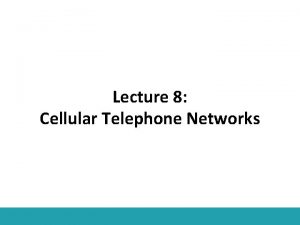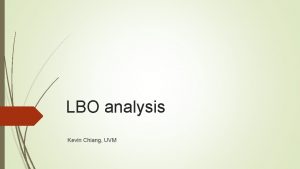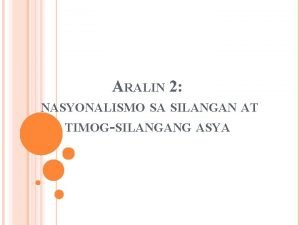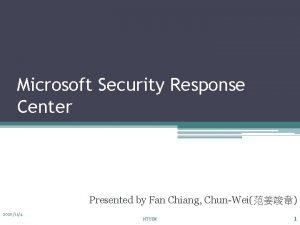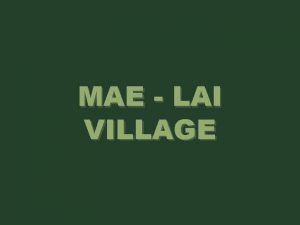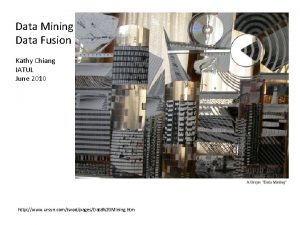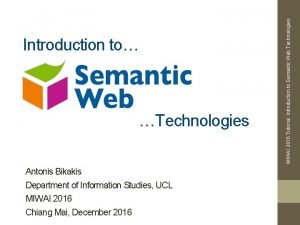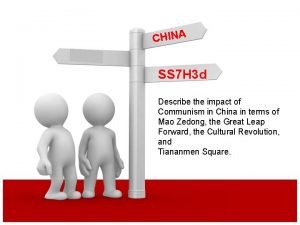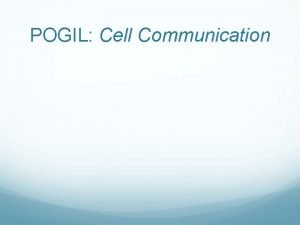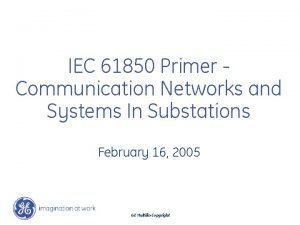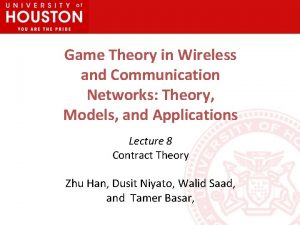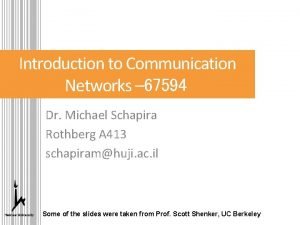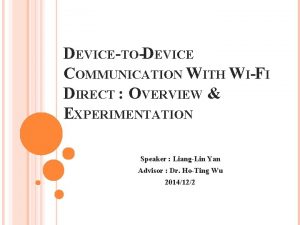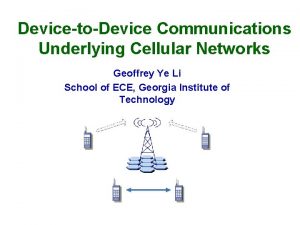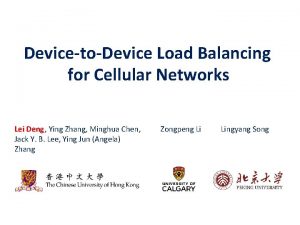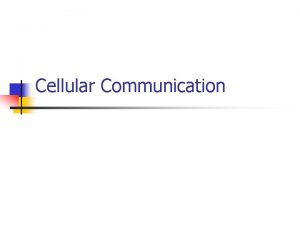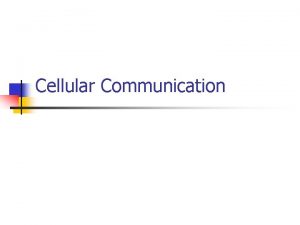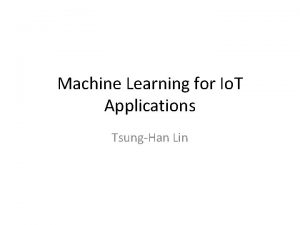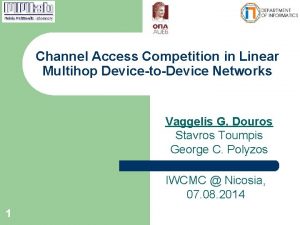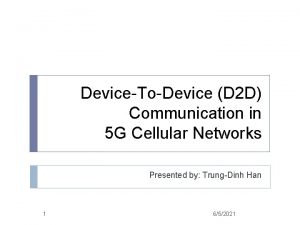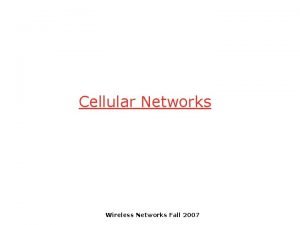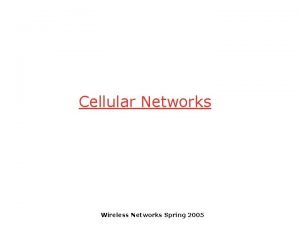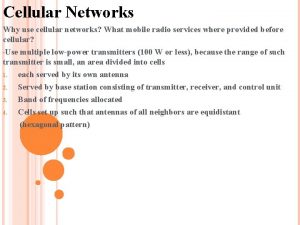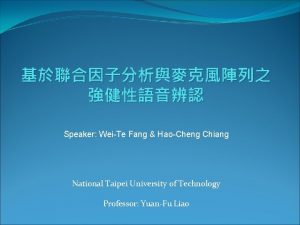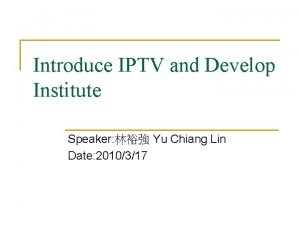DevicetoDevice Communication in Cellular Networks Speaker TsungHan Chiang





















- Slides: 21

Device-to-Device Communication in Cellular Networks Speaker: Tsung-Han Chiang Date: Feb. 24, 2011 1

Papers Resource Sharing Optimization for Device-to-Device Communication Underlaying Cellular Networks n IEEE Transactions on Wireless Communication, Vol. 10, No. 8, August 2011 Resource Allocation Optimization for Device-to-Device Communication Underlaying Cellular Networks n IEEE 73 rd Vehicular Technology Conference Spring 2011 Device-to-Device Communication in Cellular Networks Using Fractional Frequency Reuse n 2011 17 th Asia-Pacific Conference on Communications (APCC) 2

Papers Resource Sharing Optimization for Device-to-Device Communication Underlaying Cellular Networks n IEEE Transactions on Wireless Communication, Vol. 10, No. 8, August 2011 Resource Allocation Optimization for Device-to-Device Communication Underlaying Cellular Networks n IEEE 73 rd Vehicular Technology Conference Spring 2011 Device-to-Device Communication in Cellular Networks Using Fractional Frequency Reuse n 2011 17 th Asia-Pacific Conference on Communications (APCC) 3

Introduction There is an increasing requirement for local communication, such as games between mobile phones, video sharing, and information broadcast in hot spot area like market. The D 2 D communication reduces the transmit power of terminal, which increases the working time of terminal and improves the energy efficiency. The D 2 D communication can decrease the load of base station via direct transportation. The D 2 D communication has the advantage that licensed spectrum is allocated to local communication. 4

Introduction The BS is capable of coordinating the interference between cellular communication and D 2 D communication by proper power control and resource allocation with the channel state information (CSI) of all involved links. In prior studies, one D 2 D pair reused the resource of only one cellular user whenever there was one or more cellular user in the system. In actual networks, cellular users are more than D 2 D pairs generally, so the spectrum is not used efficiently when one D 2 D pair reuses the resource of only one cellular user. 5

System Model The authors assume that the BS has the CSI of all involved links. The available resources are allocated to the cellular users and the D 2 D pair based on the CSI. 6

System Model 7

Resource Allocation Algorithm By applying the Shannon capacity formula, the sum throughput of cellular communication and D 2 D communication of the four methods can be expressed as: 8

Numerical Simulation 9

Numerical Simulation 10

Numerical Simulation 11

Papers Resource Sharing Optimization for Device-to-Device Communication Underlaying Cellular Networks n IEEE Transactions on Wireless Communication, Vol. 10, No. 8, August 2011 Resource Allocation Optimization for Device-to-Device Communication Underlaying Cellular Networks n IEEE 73 rd Vehicular Technology Conference Spring 2011 Device-to-Device Communication in Cellular Networks Using Fractional Frequency Reuse n 2011 17 th Asia-Pacific Conference on Communications (APCC) 12

Introduction In order to accommodate huge multimedia traffic, capacity of cellular networks should be enhanced by extending available frequency band or deploying new e. NBs. In pre-existing cellular networks, e. NB should relay UE’s data even though users located in same cell coverage communicate with each other. Pre-existing communication increases communication delay and offered load to e. NB because of densely crowded user. 13

Introduction However, D 2 D UEs may generate high interference to e. NB relaying UEs located in their communication areas if they use the same spectrum with the e. NB relaying UEs for data transmission. 14

Preliminaries Performance of the cellular network, such as channel quality of UEs in cell outer region, is primarily affected by inter-cell interference (ICI). In frequency reuse factor (FRF) of one, since every cell uses same frequency band for data transmission, serious interference to UEs in cell outer region can be generated from neighboring cell. The simplest way to alleviate ICI is to use FRF greater than one. However, it may decrease spatial spectrum efficiency of the cellular network. 15

Preliminaries Inter-cell interference coordination (ICIC) can be classified into dynamic ICIC scheme and static ICIC scheme. n n The dynamic ICIC scheme coordinates interference between adjacent cells by dynamically allocating radio resource and adjusting transmission power of e. NB. The static ICIC scheme such as fractional frequency reuse (FFR) statically determines the radio resources used for cell inner and cell outer regions to avoid interference between neighboring cells. 16

Proposed Scheme 17

Performance Evaluation 18

Performance Evaluation 19

Performance Evaluation 20

Conclusion Mobility Scalable Interference between D 2 D links Broadcast and multicast 21
 Cellular telephony in computer networks
Cellular telephony in computer networks Difference between datagram and virtual circuit operation
Difference between datagram and virtual circuit operation Backbone networks in computer networks
Backbone networks in computer networks Kevin chiang uvm
Kevin chiang uvm Holiday garden hotel & resort chiang mai
Holiday garden hotel & resort chiang mai Dr. sun yat-sen komunismo
Dr. sun yat-sen komunismo Chiang mai azure development
Chiang mai azure development Mae lai village chiang mai
Mae lai village chiang mai Iatul
Iatul Chiang kai shek
Chiang kai shek Chiang
Chiang Chiang kai shek
Chiang kai shek Chiang kai shek
Chiang kai shek Chiang
Chiang Patrick chiang
Patrick chiang Chiang kai-shek
Chiang kai-shek Life story outline
Life story outline Implantes dentales precio chiang mai
Implantes dentales precio chiang mai Cell communication pogil
Cell communication pogil Iec 61850 communication networks and systems in substations
Iec 61850 communication networks and systems in substations Game theory in wireless and communication networks
Game theory in wireless and communication networks Introduction to communication networks
Introduction to communication networks
